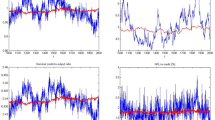Abstract
In existing literature, commercial banks are often considered mere financial intermediaries that facilitate the flow of credit in an imperfect credit market. However, as demonstrated in the history of financial instability, the behavior of financial institutions plays an important role. This paper examines how lenders’ attitudes affect macroeconomic performance. In our analysis, the economy is composed of multiple borrowers (firms) and one lender (bank). Each borrower is directly connected to the lender through its credit contract. At the same time, each borrower is indirectly connected to all the other borrowers within the credit network. Using this model, we execute computer simulations to examine the economic consequences of lending attitudes. The results of the simulations demonstrate that the bank’s lending attitude functions as a financial accelerator; that is, it significantly affects the dynamics of the economic system through the credit network. Consequently, the same level of exogenous shock generates completely different outcomes depending on the different lending attitudes. The results also show that there exists an optimal lending attitude that leads to high economic growth and a stable growth path.
Similar content being viewed by others
References
Allen F, Gale D (2000) Financial contagion. J Polit Econ 108(1): 1–33
Allen F, Carletti E, Gale D (2009) Interbank market liquidity and central bank intervention. J Monetary Econ 56(5): 639–652
Asanuma D (2010) A model of credit rationing without asymmetric information: an inquiry into the credit market during an economic depression. Evol Inst Econ Rev 7(2): 261–277
Axtell R (2001) Zipf low distribution of US firm sizes. Science 293(5536): 1818–1820
Bernanke B, Gertler M (1989) Agency costs, net worth and business fluctuations. Am Econ Rev 79(1): 14–31
Bernanke B, Gertler M, Gilchrist S (1999) The financial accelerator in a quantitative business cycle framework. In: Taylor JB, Woodford M (eds) Handbook of macroeconomics. North-Holland, Amsterdam, pp 1342–1393
Bossone B (2001) Do banks have a future? A study on banking and finance as we move into the third millennium. J Bank Finance 25(12): 2239–2276
Carlstrom CT, Fuerst TS (1997) Agency costs, net worth and business fluctuations: a computable general equilibrium analysis. Am Econ Rev 87(5): 893–910
Delli Gatti D, Guilmi CD, Gaffeo E, Gallegati M, Giulioni G, Plestrini A (2005) A new approach to business fluctuation: heterogeneous interacting agents, scaling laws and financial fragility. J Econ Behav Organ 56(4): 489–512
Delli Gatti D, Guilmi CD, Gaffeo E, Gallegati M, Giulioni G, Plestrini A (2008) Emergent macroeconomics. Springer, Milan
Delli Gatti D, Gallegati M, Greenwald B, Russo A, Stiglitz JE (2006) Business fluctuations in a credit network economy. Phys A 370(1): 68–74
Delli Gatti D, Gallegati M, Greenwald B, Russo A, Stiglitz JE (2009) Business fluctuations and bankruptcy avalanches in an evolving network economy. J Econ Interact Coord 4(2): 195–212
Delli Gatti D, Gallegati M, Greenwald B, Russo A, Stiglitz JE (2010) The financial accelerator in an evolving credit network. J Econ Dyn Control 34(9): 1627–1650
Diamond DW, Dybvig RG (1983) Bank runs, deposit insurance, and liquidity. J Polit Econ 91(3): 401–419
Fama EF (1980) Banking in the theory of finance. J Monetary Econ 6(1): 39–57
Freixas X, Rochet JC (2008) Microeconomics of banking, 2nd edn. MIT Press, Cambridge
Galbraith JK (1990) A short history of financial euphoria. Penguin Books, New York
Gali J (2008) Monetary policy, inflation, and the business cycle: an introduction to the new Keynesian framework. Princeton University Press, Princeton
Greenwald JE, Stiglitz B (1993) Financial market imperfections and business cycles. Q J Econ 108(1): 77–114
Kalecki M (1939) Essays in the theory of economic fluctuations. Routledge, Oxford
Kaldor N (1982) The scourge of monetarism. Oxford University Press, Oxford
Keynes JM (1937) The “ex-ante” theory of the rate of interest. Econ J 47(188): 663–669
Kindleberger CP, Aliber RZ (2005) Manias, panics and crashes: a history of financial crisis, 5th edn. Palgrave Macmillan, Basingstoke
Kiyotaki N, Moore J (1997) Credit cycles. J Polit Econ 105(2): 221–248
Lavoie M (1996) Horizontalism, structuralism, liquidity preference and the principle of increasing risk. Scot J Polit Econ 43(3): 275–300
Lavoie M (2006) Introduction to post-Keynesian economics. Palgrave Macmillan, Basingstoke
Minsky HP (1975) John Maynard Keynes. Columbia University Press, New York
Minsky HP (1982) Can “it” happen again? Essays on instability and finance. M.E. Sharpe, Armonk
Rochon LP (1999) Credit, money and production: an alternative post-Keynesian approach. Edward Elgar, Cheltenham
Woodford M (2003) Interest and prices: foundations of a theory of monetary policy. Princeton University Press, Princeton
Wray R (1995) Money and credit in capitalist economies: the endogenous money approach. Edward Elgar, Cheltenham
Author information
Authors and Affiliations
Corresponding author
Rights and permissions
About this article
Cite this article
Asanuma, D. Lending attitude as a financial accelerator in a credit network economy. J Econ Interact Coord 8, 231–247 (2013). https://doi.org/10.1007/s11403-012-0102-9
Received:
Accepted:
Published:
Issue Date:
DOI: https://doi.org/10.1007/s11403-012-0102-9
Keywords
- Agent-based model
- Credit network economy
- Bank’s lending attitudes
- Financial accelerator
- Optimal lending attitude




